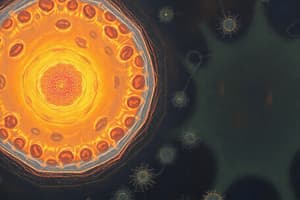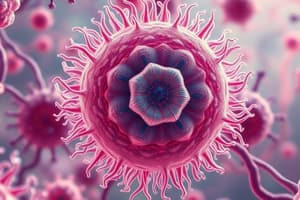Podcast
Questions and Answers
What key characteristic defines a lytic cycle in bacteriophages?
What key characteristic defines a lytic cycle in bacteriophages?
- The cycle is initiated by UV light
- Progeny virus particles are produced rapidly (correct)
- Phage genome integrates into the host genome
- The cycle does not harm the host cell
Which factor can induce a lysogenic cycle to transition into a lytic cycle?
Which factor can induce a lysogenic cycle to transition into a lytic cycle?
- Presence of a ghost phage
- Lower activation energy
- Integration of phage genome into host genome
- Exposure to UV light (correct)
During which stage of the lytic cycle does the assembly of new virions occur?
During which stage of the lytic cycle does the assembly of new virions occur?
- Maturation (correct)
- Penetration
- Release
- Adsorption
How do enzymes primarily speed up chemical reactions?
How do enzymes primarily speed up chemical reactions?
What happens to the enzyme once the reaction is catalyzed?
What happens to the enzyme once the reaction is catalyzed?
What is the role of a prophage in the lysogenic cycle?
What is the role of a prophage in the lysogenic cycle?
Which model suggests that the enzyme does not change shape upon substrate binding?
Which model suggests that the enzyme does not change shape upon substrate binding?
What characteristic is shared by all prokaryotic cells?
What characteristic is shared by all prokaryotic cells?
Which cellular structure is larger in eukaryotes compared to prokaryotes?
Which cellular structure is larger in eukaryotes compared to prokaryotes?
What feature is unique to the lysogenic cycle and not found in the lytic cycle of bacteriophages?
What feature is unique to the lysogenic cycle and not found in the lytic cycle of bacteriophages?
Which cell type divides using binary fission?
Which cell type divides using binary fission?
In which type of organism would you find cells with linear and complex DNA?
In which type of organism would you find cells with linear and complex DNA?
What is a characteristic of the lytic cycle of bacteriophages?
What is a characteristic of the lytic cycle of bacteriophages?
What is a function of the cytoskeleton in eukaryotic cells?
What is a function of the cytoskeleton in eukaryotic cells?
Which of the following organisms contains only unicellular structures?
Which of the following organisms contains only unicellular structures?
Flashcards
Lytic Cycle
Lytic Cycle
A viral reproductive cycle leading to quick production of progeny virus particles and host cell lysis.
Lysogenic Cycle
Lysogenic Cycle
A viral reproductive cycle where the phage genome integrates into the host genome without immediate harm to the host.
Prophage
Prophage
The integrated viral genome within the host bacterial chromosome in the lysogenic cycle.
Lysogen
Lysogen
Signup and view all the flashcards
Activation Energy
Activation Energy
Signup and view all the flashcards
Enzyme-Substrate Complex
Enzyme-Substrate Complex
Signup and view all the flashcards
Induced Fit Model
Induced Fit Model
Signup and view all the flashcards
Prokaryotes
Prokaryotes
Signup and view all the flashcards
Eukaryotes
Eukaryotes
Signup and view all the flashcards
Bacteriophages
Bacteriophages
Signup and view all the flashcards
Cell Wall
Cell Wall
Signup and view all the flashcards
Binary Fission
Binary Fission
Signup and view all the flashcards
Ribosomes
Ribosomes
Signup and view all the flashcards
Study Notes
Prokaryotic vs. Eukaryotic Cells
-
Prokaryotic cells lack a nucleus and membrane-bound organelles.
-
Examples include bacteria and archaea.
-
Size: 0.1 micrometers to 5 micrometers.
-
Unicellular only.
-
DNA is circular.
-
70S ribosomes.
-
Cytoskeleton made of analogous proteins.
-
Reproduce asexually via binary fission.
-
Cell wall in all prokaryotes
-
Eukaryotic cells have a nucleus and membrane-bound organelles.
-
Larger than prokaryotic cells (10-100 micrometers).
-
Can be unicellular or multicellular.
-
Examples include plants, animals, and fungi.
-
DNA is linear and complex.
-
80S ribosomes.
-
Cytoskeleton made of actin, intermediate filaments, and microtubules.
-
Reproduce sexually or asexually via mitosis.
-
Cell walls found in plants and fungi.
-
Both types of cells:
- Contain DNA as genetic material
- Contain cytoplasm
- Use ribosomes in protein synthesis
- Have a cell membrane made of phospholipids
Viral Replication Cycles
- Viruses are acellular particles, non-living until they invade a host.
- Bacteriophages are viruses that infect bacteria only.
- Structure: capsid head (nucleic acid), tail sheath, tail fibers.
- Two replication cycles: lytic and lysogenic.
Lytic Cycle
- Temperate/non-virulent phages.
- Kills host cell through lysis.
- No prophage stage.
- Phage replication independent of host DNA.
- Complete takeover of host cell mechanisms.
- High phage genome productivity.
- Fast process; progeny virions released quickly.
- No lysogenic cycle transition.
Lysogenic Cycle
-
Virulent phages.
-
Does not harm the host cell initially.
-
Phage DNA integrates into host genome (prophage).
-
Replication of prophage along with host DNA.
-
Does not take complete control of host mechanisms.
-
Low phage genome productivity.
-
Slow process; no progeny virions released immediately.
-
Can transition to lytic cycle under certain conditions (UV, lack of nutrients, chemicals).
-
Five steps of both cycles (Lytic): adsorption, penetration, replication, maturation, lysis/release
-
Ghost refers to empty phage particle remaining outside bacteria after lysis/release.
-
Lysogenic conversion: prophage induces phenotypic changes in the host.
Enzymes
- Enzymes are specialized proteins that speed up chemical reactions.
- They lower the activation energy (minimum energy needed for reaction).
- Do not change the overall energy of the reaction.
- Enzymes bind to substrates at the active site.
- Enzyme-substrate complex forms (lock-and-key or induced fit model).
- Lock-and-key: enzyme and substrate fit perfectly.
- Induced fit: enzyme changes shape to fit the substrate.
- Product forms and is released; enzyme is unchanged and can bind more substrates.
Studying That Suits You
Use AI to generate personalized quizzes and flashcards to suit your learning preferences.




